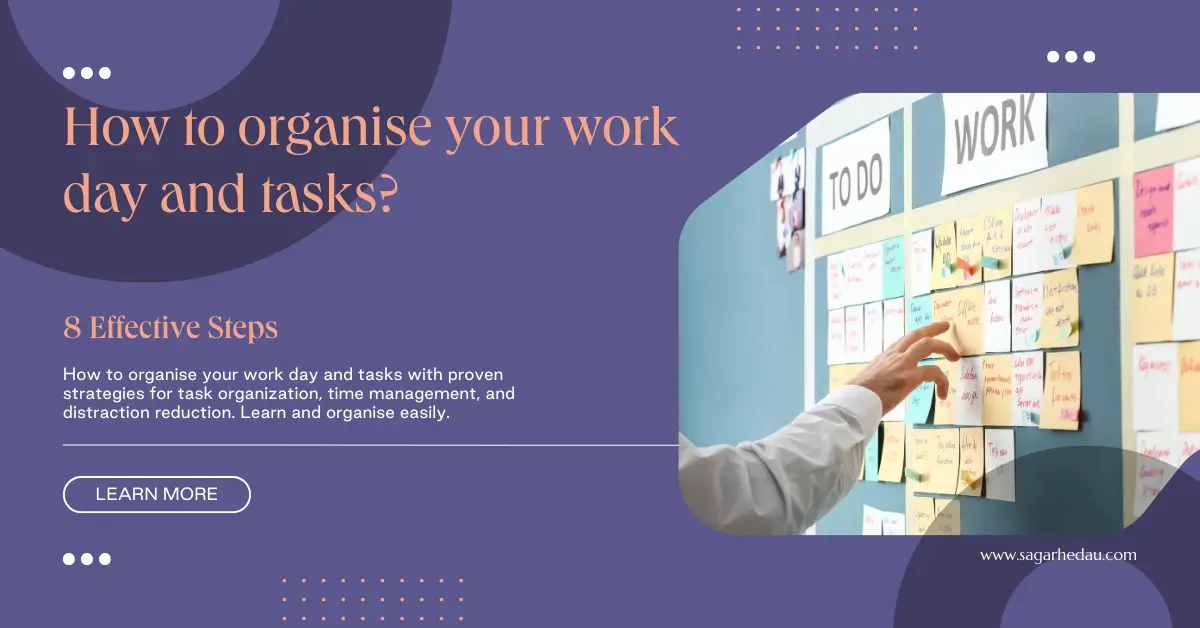I DON’T HAVE TIME FOR THIS. Really??? In 16 hours of being awake, you don’t have time for this? This is a very common scenario today. Not having time, but having time and not realizing it. This is what creates a disorganized day. So, how to organize your work day and tasks then? Follow some guidelines and implement them.
We know that, in today’s fast-paced professional environment, learning how to organise your work day and tasks effectively isn’t just helpful—it’s essential for survival. Whether you’re managing multiple projects or tackling a seemingly endless to-do list, a proper organisation can transform your productivity and reduce workplace stress.
The art of work organisation has evolved beyond simple to-do lists into a sophisticated approach that combines proven methodologies with personalised systems. In this guide, we’ll explore practical strategies to help you take control of your tasks and transform your daily work routine from chaotic to seamlessly organised.
How to organise your work day and tasks daily?
It is really that tough? For some, NO. For some, YES, very tough. So, to get organised and align your daily activities, you can follow the below-mentioned plan on how to organise your work day and tasks daily:
Morning Planning Routine
Begin your day with a deliberate 15-minute planning session before diving into work. Review your calendar whilst enjoying your morning tea, then outline your day’s objectives.
This quiet time allows you to mentally prepare and organise your thoughts without interruption. Resist the urge to check emails until your planning is complete.
Setting Priorities
Identify your ‘Big Three’ tasks—the most crucial objectives that align with your goals and deadlines. Use the urgent-important matrix to categorise tasks: urgent and important tasks first, followed by important but not urgent ones.
Remember that busy work often masquerades as urgent; focus on tasks that genuinely move your projects forward.
Time Blocking Basics
Segment your day into focused work periods, allocating specific timeframes for different activities. For instance, reserve your peak performance hours (typically mornings) for complex tasks, schedule meetings in blocks, and designate specific times for email checking.
Create buffer zones between blocks to accommodate unexpected issues and prevent schedule overflow.
Creating an Effective Task Management System
Here’s a detailed breakdown of how to manage your time easily:
Choosing the Right Tools
Select tools that match your working style and needs. Whether it’s Trello for visual thinkers, Microsoft To-Do for simplicity, or Notion for complex projects, ensure your chosen tool feels intuitive and integrates with your existing workflow. The best tool is one you’ll actually use consistently, rather than the one with the most features.
Digital vs Paper Methods
Digital tools offer cloud syncing, easy sharing, and quick reorganisation, perfect for collaborative work and complex projects. However, paper planners provide a tactile experience and better information retention—plus they never need charging.
Consider a hybrid approach: digital for team projects and long-term planning, paper for daily tasks and personal notes.
Task Categorisation Methods
Implement a clear system using tags or labels: ‘Urgent’, ‘Important’, ‘Quick Win’ (tasks under 10 minutes), and ‘Deep Work’ (requiring focused attention).
Colour-code different project categories or departments. Group related tasks together and assign energy levels required—’High Focus’ versus ‘Admin’—to match your daily energy patterns.
The Four-Step Daily Workflow:
- Capturing Tasks
Keep a single collection point for all incoming tasks, whether it’s a notebook or a digital app. Write down everything immediately—ideas, commitments, and to-dos. This ‘brain dump’ prevents tasks from slipping through the cracks and reduces mental load. - Processing and Organising
Review captured tasks daily. Ask three questions: Is it actionable? Can it be done in under two minutes? Does it need to be delegated? Break larger tasks into smaller, manageable steps. Assign due dates and priority levels. Move tasks to appropriate project lists or calendar slots. - Regular Reviews
Conduct weekly reviews every Friday afternoon. Review completed tasks, update project statuses, and plan the week ahead. Monthly reviews help track bigger goals and adjust priorities. Clear your task list of outdated items and celebrate the progress made towards objectives. - Taking Action
Focus on completion over perfection. Start with two-minute tasks to build momentum. Tackle complex tasks during your peak energy hours. Group similar tasks together to maintain flow. If you’re procrastinating on a task, break it down into smaller, more manageable steps.
Effective Time Management Techniques
So, how to organise your work day and tasks and keep track? Easy. Check and implement the following steps to get the maximum output in your limited time:
The Pomodoro Method
- Work in focused 25-minute sprints, followed by 5-minute breaks.
- After four ‘pomodoros’, take a longer 15-30 minute break.
- During each sprint, focus solely on one task and resist all interruptions.
- Keep a small notepad nearby to jot down distracting thoughts or urgent matters that arise.
- This technique prevents burnout whilst maintaining high productivity and creates a sustainable rhythm throughout your workday.
2-Minute Rule
- If a task takes less than two minutes, do it immediately rather than adding it to your task list.
- This applies to quick emails, brief phone calls, or simple admin tasks.
- The principle prevents the accumulation of small tasks that can clutter your to-do list and create mental overhead.
- However, be cautious not to let multiple two-minute tasks derail your planned focus time.
Energy Management vs Time Management
- Instead of focusing solely on time allocation, align tasks with your natural energy patterns.
- Identify your peak performance hours—typically morning for most—and schedule complex, creative work during these periods.
- Save routine, administrative tasks for lower-energy periods.
- Track your productivity patterns for a week to understand your unique energy fluctuations.
- This approach ensures you’re maximising your cognitive resources rather than just managing minutes and hours.
Task Batching
- Group similar tasks together and complete them in dedicated time blocks.
- For example, handle all emails, phone calls, or data entry tasks in one session.
- This reduces the mental energy lost when switching between different types of work.
- Batching minimises context-switching costs and helps maintain focus.
- Schedule these batches during appropriate energy levels—communications during medium energy, deep work during peak energy.
The 90-Minute Focus Block
- Work in 90-minute focused sessions, aligning with your body’s natural ultradian rhythm—the cycle of peak performance and rest.
- During these blocks, eliminate all distractions and work intensely on a single important task or project.
- Follow each block with a 20-minute break for recovery.
- This method typically allows for three to four highly productive sessions per day, maximising your cognitive output.
Time Boxing
- Assign specific time limits to tasks before starting them.
- For instance, allocate 45 minutes for report writing or 30 minutes for email processing.
- This creates urgency and helps prevent perfectionism and procrastination.
- When the allocated time expires, either finish the task or schedule another time box if needed.
- This technique helps maintain focus and prevents tasks from expanding unnecessarily.
How to organise your work day and tasks without interruptions?
You can keep track of all the activities you do. If you get habituated to noting them down or preplanning your today and tomorrow. Check the following for example:
Email Management Strategies
- Regain control of your inbox by implementing smart email practices.
- First, set aside designated times to check and respond to emails, such as mid-morning and mid-afternoon.
- Use folders, filters, and rules to automatically sort and prioritise messages.
- Aim for ‘Inbox Zero’ at the end of each workday by either actioning, delegating or scheduling emails rather than letting them accumulate.
- When possible, turn off desktop and mobile notifications to avoid constant disruptions.
Meeting Boundaries
- Limit meeting time and attendance to the bare essentials.
- Set clear start and end times, and distribute agendas in advance to keep discussions focused.
- Block out chunks of focus time in your calendar to prevent back-to-back meetings from draining your energy.
- Be selective about which meetings you truly need to attend, and don’t hesitate to decline invitations that don’t align with your priorities.
- When in meetings, silence notifications and close unneeded laptop or tablet applications to avoid the temptation to multitask.
Workspace Organisation
- Maintain a tidy and distraction-free work environment, both physical and digital.
- Clear your desk at the end of each day, filing away documents and minimising clutter.
- Organise your computer’s file structure logically and keep frequently used items within arm’s reach.
- Turn off notifications for non-essential applications and browser tabs.
- Use noise-cancelling headphones or play ambient background music to create a focused atmosphere.
- A well-organised workspace reduces visual stimuli and mental drag.
How to organise your work day and tasks with the help of technology?
Maintaining productivity and focus in today’s digital world filled with constant distractions can be a challenge. Fortunately, there are a variety of apps designed to help you take control of your time and boost your efficiency.
From classic Pomodoro timers to visual project management tools and distraction-blocking apps, these five top picks offer effective solutions to organise your workday and stay on top of your tasks.
Pomodoro Technique Apps:
- Examples: Tomato Timer, Focus Timer, Pomodoro Technique
- These apps use the Pomodoro technique of 25-minute work sprints followed by short breaks to improve focus and productivity.
Trello:
- A visual project management tool that uses boards, lists, and cards to organise tasks and workflows.
- Allows for collaborative task tracking, deadline setting, and progress monitoring.
Todoist:
- A comprehensive to-do list and task management app with features like priority levels, due dates, and project organisation.
- Provides a clean interface and cross-platform sync to access tasks from anywhere.
RescueTime:
- Tracks your computer and mobile usage to provide detailed reports on how you spend your time.
- Helps identify time-wasting activities and provides productivity scores to improve time management.
Forest:
- A unique app that grows a virtual tree when you commit to focusing on a task without using your phone.
- Encourages mindfulness and reduces smartphone distractions during important work sessions.
All these things can help but only when you decide that you need to get organized. “How to organise your work day and tasks?” is an easy question to answer with discipline. So, if you lack that, you will always lack time. Let’s get serious and do what can be done easily. Manage and utilize OUR TIME.
Conclusion
Effective work organisation is not a one-size-fits-all endeavour—it requires an ongoing process of experimentation and refinement. The strategies outlined in this guide provide a solid foundation, but the true power lies in finding the right combination that aligns with your unique working style and priorities.
Remember, organisation is not about perfection; it’s about progress. Start small by implementing just one or two new habits, and build from there. Over time, these techniques will become second nature, freeing up mental bandwidth to focus on your most important objectives.
The journey to a well-organised workday is filled with small victories—completing your ‘Big Three’ tasks, maintaining an empty inbox, or simply having the peace of mind to leave the office on time. Celebrate these wins, however modest, as you streamline your workflow and reclaim your time.
Ultimately, a organised approach to work is about more than just ticking items off a list. It’s about creating the space and headspace to do your best work, manage stress, and achieve a healthy work-life balance. Embrace these strategies, and watch your productivity, focus, and overall wellbeing flourish.



